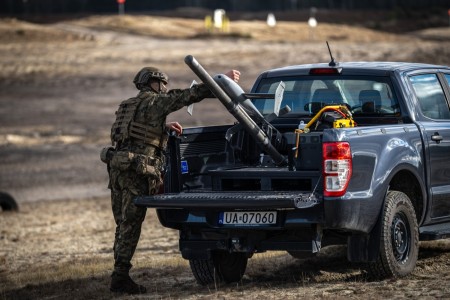US, Polish and Romanian soldiers demonstrated a new counter-uncrewed aircraft system (C-UAS) capability on November 18, showing how allies are adapting to the growing drone threat along NATO’s eastern flank.
The live-fire event at the Nowa Dęba Training Area in Poland capped a two-week course that brought together air defenders from all three nations. Soldiers trained on a mobile system that uses radar, electro-optical sensors and a small interceptor drone to detect, track and defeat hostile UAS.
All major components fit on a light tactical vehicle or pickup truck, enabling a four-person crew to move, emplace and reload the system in minutes. During the demonstration, crews used a truck-mounted launcher to fire interceptors against surrogate ‘enemy’ drones and recover them by parachute for reuse in training.
“It’s very lethal, very effective, but the key piece here is that it’s cost effective,” said Brig. Gen. Curtis King, commanding general of the 10th Army Air and Missile Defense Command.
King noted that the same type of interceptor has already been used in combat in Ukraine against Russian unmanned systems. There, he said, the capability has been “highly effective and lethal against one-way attack drones in Ukraine,” and is part of “the latest technology that’s being fought in Ukraine right now.”l.
Polish and Romanian officers at Nowa Dęba said recent airspace violations and drone incidents over their territory accelerated efforts to field practical counter-UAS options.
The course followed a train-the-trainer model. U.S. Soldiers from 1st Battalion, 57th Air Defense Artillery Regiment trained alongside Polish and Romanian counterparts through classroom instruction, simulator work and live launches. The 20-day course was designed to transform a diverse group of personnel into expert instructors for a system battle-tested in Ukraine. None of the participants had previous experience with the system, and most had little to no military drone experience. The new graduates are expected to form the core of future national training teams.
The training and demonstration in Nowa Dęba support NATO’s Operation Eastern Sentry and the Eastern Flank Deterrence Line, which seeks to link ground-based air and missile defense, aviation, sensors, and fires into a layered architecture along NATO’s flank.
For more information
Image: A Polish soldier prepares a C-UAS system during a demonstration in Nowa Deba Training Area, Poland, Nov. 18, 2025. (US Army photo)




